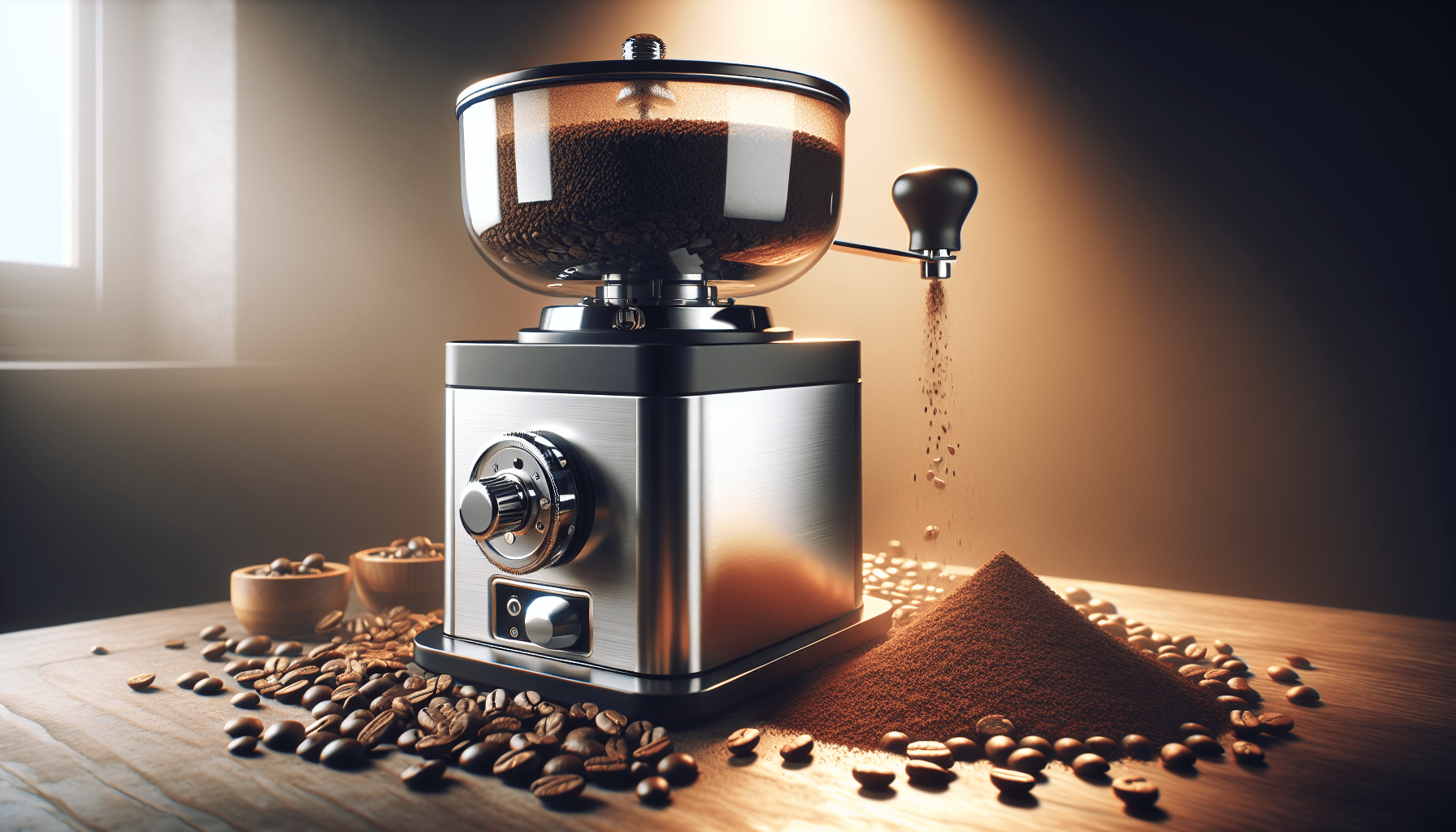We all know that a delicious cup of coffee begins with freshly ground beans, but finding the perfect coffee grinder can be a challenging task. With so many options available on the market, it’s easy to become overwhelmed and unsure of where to even begin. That’s why we’ve put together this comprehensive guide to help you navigate the world of coffee grinders and make an informed decision. From understanding the different types of grinders to considering your budget and brewing method, we’ve got you covered. So grab a cup of joe and get ready to discover the key factors to consider when choosing the perfect coffee grinder for your needs.
Types of Coffee Grinders
When it comes to selecting a coffee grinder, there are a few options to choose from. The first decision you’ll need to make is whether you want a blade grinder, a burr grinder, or a manual grinder.
Blade Grinders
Blade grinders are the most basic type of coffee grinder available. They typically consist of a motorized base with a spinning blade that chops the coffee beans. While blade grinders are affordable and easy to use, they tend to produce an inconsistent grind size. This can result in an uneven extraction, leading to a less-than-ideal cup of coffee.
Burr Grinders
Burr grinders, on the other hand, use two revolving abrasive surfaces (burrs) to crush and grind the coffee beans. The result is a much more uniform grind size, which is crucial for achieving the desired flavor and aroma in your coffee. Burr grinders are available in both electric and manual variants, offering more control and precision compared to blade grinders.
Manual Grinders
For the coffee enthusiasts who enjoy a hands-on approach, manual grinders are a fantastic option. Manual grinders require a bit of effort, as you’ll need to manually turn a crank or handle to grind the coffee beans. However, they offer complete control over the grind size and are often more portable and affordable than electric burr grinders.
Grind Size Options
The grind size of your coffee beans plays a crucial role in determining the taste and quality of your brewed coffee. Different brewing methods require different grind sizes, so it’s important to choose a grinder that offers the desired range of options.
Coarse Grind
A coarse grind is best suited for brewing methods such as French press and cold brew. This grind size consists of larger particles, which allows for a slower extraction and a fuller-bodied cup of coffee.
Medium Grind
A medium grind is typically used for drip coffee makers and pour-over methods like the Chemex or V60. This grind size strikes a balance between extraction time and flavor, resulting in a well-rounded cup of coffee.
Fine Grind
A fine grind is ideal for espresso machines and moka pots. The smaller particles allow for a quicker extraction, resulting in a stronger and more concentrated coffee flavor.
Extra Fine Grind
An extra fine grind is often used for Turkish coffee, where the coffee grounds are powder-like in consistency. This ultra-fine grind size ensures a potent and aromatic cup of coffee using the traditional Turkish brewing method.

Electric vs Manual
Once you’ve decided on the type of grinder and the desired grind size, another important consideration is whether to opt for an electric or manual grinder.
Electric Grinders
Electric grinders are the most convenient option, particularly if you make multiple cups of coffee every day. With the push of a button, electric grinders provide fast and consistent grinding. They often come with additional features such as programmable settings and timers, allowing you to achieve the perfect grind for your preferred brewing method.
Manual Grinders
If you prefer to be more involved in the coffee-making process, manual grinders can be a great choice. Manual grinders require manual effort to grind the beans, which can be a meditative and enjoyable ritual for many coffee enthusiasts. Additionally, manual grinders are portable, making them perfect for travel or outdoor adventures.
Budget Considerations
Your budget will inevitably play a role in your coffee grinder selection. Here are some considerations based on various budget ranges.
Entry-level Budget
If you’re on a tight budget, you can still find decent blade grinders or entry-level burr grinders that will serve your basic coffee grinding needs. While they may not offer all the bells and whistles of their higher-end counterparts, they can still produce a satisfactory cup of coffee.
Mid-range Budget
For a more substantial investment, mid-range burr grinders provide better build quality, more grind size options, and improved grind consistency. These grinders are suitable for those who want to elevate their coffee brewing experience without breaking the bank.
High-end Budget
If you’re a serious coffee enthusiast or a professional barista, a high-end burr grinder may be worth the splurge. These grinders offer superior quality, precision, and durability. They often come with advanced features, such as grind size adjustments in micro-increments, customizable settings, and noise reduction technology.

Grinder Size
The size of your coffee grinder is another consideration that shouldn’t be overlooked. Depending on your kitchen setup and personal preferences, you’ll need to choose between compact grinders and large grinders.
Compact Grinders
Compact grinders are designed with space-saving in mind. These smaller machines are perfect for kitchens with limited countertop space or for those who value portability. Compact grinders are often electric and easily fit into small nooks or can be stored away when not in use.
Large Grinders
If you have ample counter space and entertain guests frequently, a larger grinder might be the right choice for you. Large grinders generally offer more capacity and may have additional features like built-in scales or timers. Keep in mind that bigger grinders can also mean louder operation and a more significant investment.
Grind Speed
Grind speed is an important factor to consider, especially if you value efficiency and convenience in your coffee grinding routine.
Variable Speed Grinders
Variable speed grinders allow you to adjust the grinding speed based on your preferences and the brewing method you use. This flexibility gives you more control over the extraction process and allows you to experiment with different flavors and profiles.
Single Speed Grinders
Single speed grinders, as the name suggests, operate at a fixed speed. While they may lack the flexibility of variable speed grinders, they can still deliver consistent results and are generally more affordable.

Capacity
The capacity of your coffee grinder refers to the amount of coffee beans it can hold at once. This is an essential consideration, especially if you frequently brew large quantities of coffee or if you’re grinding coffee for multiple people.
Small Capacity Grinders
For solo coffee drinkers or those with limited storage space, a small capacity grinder may be the ideal choice. These grinders typically have a hopper that can hold enough coffee beans for 1-2 servings, making them both practical and space-efficient.
Large Capacity Grinders
If you regularly brew coffee for a household or enjoy hosting coffee gatherings, a grinder with a larger capacity will be more suitable. These grinders can accommodate larger quantities of coffee beans, reducing the need for frequent refills.
Durability and Material
The durability and construction material of your coffee grinder play a significant role in its longevity and performance.
Stainless Steel Grinders
Stainless steel grinders are known for their durability and resistance to rust and corrosion. They are often the top choice for those seeking a long-lasting grinder that can withstand frequent use and exposure to moisture.
Ceramic Grinders
Ceramic grinders are valued for their ability to retain sharpness over time. They provide a consistent grind size and generate less heat during the grinding process, preserving the coffee’s flavors. However, they can be more prone to breakage if mishandled.
Plastic Grinders
Plastic grinders are lightweight and affordable options that still get the job done. While they may not be as durable as their stainless steel or ceramic counterparts, they can be a good choice for occasional use or for those on a tight budget.

Ease of Cleaning
Nobody wants a coffee grinder that’s a hassle to clean. Choosing a grinder with easy-to-clean features can save you time and frustration in the long run.
Detachable Parts
Grinders with detachable parts are easier to clean since you can take them apart and reach all the nooks and crannies. Look for grinders with removable burrs or blades that can be washed separately or brushed clean.
Dishwasher Safe Grinders
Some grinders are dishwasher safe, which can make cleaning a breeze. However, it’s always a good idea to refer to the manufacturer’s instructions to ensure that all parts are indeed safe for the dishwasher.
Noise Level
For those who value a peaceful and quiet coffee routine, the noise level of a grinder may be an important consideration.
Quiet Grinders
Quiet grinders are designed with noise reduction technology to minimize the sound produced during operation. These grinders are perfect for those living in small apartments or anyone who prefers a calm and tranquil environment while brewing their coffee.
Noisy Grinders
On the other hand, some coffee enthusiasts don’t mind a little noise or may even find it adds to the coffee-making ambiance. Noisy grinders are often more affordable and offer powerful grinding capabilities, making them a suitable option for those who prioritize performance over noise level.
In conclusion, choosing the perfect coffee grinder involves considering various factors such as the type of grinder, grind size options, electric vs. manual operation, budget considerations, size, grind speed, capacity, durability, ease of cleaning, and noise level. By carefully assessing your needs and preferences in each of these categories, you’ll be able to find a coffee grinder that meets your specific requirements and elevates your coffee brewing experience to new heights. Happy grinding!

